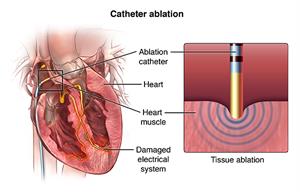Atrial Flutter
Atrial Flutter
What is atrial flutter?
Atrial flutter is one of the more common abnormal heart rhythms (arrhythmias) and involves the upper heart chambers (atria). It is caused by an abnormal electrical circuit that makes the atria beat quickly and flutter instead of fully squeezing. It can result in fast heart rates and a decrease in heart efficiency. This causes symptoms and increases the risk for stroke.
What causes atrial flutter?
Normal electrical heart impulses are generated by the sinus node (SA node) in the right atrium. This node regulates the heart rate and timing of heartbeats. The electrical impulses travel through the heart muscle in the atria, triggering the muscle to squeeze. In atrial flutter, an abnormal electrical circuit forms in the atria after some type of heart muscle damage or other heart changes. This new circuit takes over the heart rhythm causing the abnormal fluttering.
What are the risk factors for atrial flutter?
Common risk factors for atrial flutter include:- Age (the older you are, the higher the risk)
- High blood pressure
- Diabetes
- Coronary artery disease
- Heart failure
- Heart valve disease
- Obesity
- Alcohol consumption
- Lung disease
- Hyperthyroidism
- Sleep apnea
- Intensive athletic training
What are the symptoms of atrial flutter?
Atrial flutter makes the heart less efficient in pumping blood. Symptoms can include:- Shortness of breath
- Fatigue
- Chest pain
- Palpitations
- Lightheadedness
- Fainting
- Some people have minimal or no symptoms from atrial flutter.
How is atrial flutter diagnosed?
To diagnose atrial flutter, your doctor will want to record your heart rhythm. This may include:- Electrocardiography (ECG). This measures the electrical activity in your heart through tiny patches placed on your chest that are connected to a machine that records the heart rate.
- Holter monitoring. This is a portable ECG that you can wear to record your heart rhythm for 24 hours.
- Event monitoring. This type of ECG samples your heart rate over several days.
It can be difficult to capture atrial flutter if it happens sporadically or only lasts a few minutes. The longer the recording time of heart rhythm, the higher the chance atrial flutter can be recorded.
In some cases, an implanted heart recorder can be surgically placed underneath the skin overlying the heart. This can stay in place for up to 2 years of continuous heart monitoring.
How is atrial flutter treated?
The goal of treatment is to control the heart rate, prevent stroke, and maintain a normal heart rhythm.- To control heart rate, you will be given a prescription medicine that can slow down the heart rate.
- To prevent stroke, your doctor will prescribe a blood thinner (anticoagulant) to prevent the formation of a blood clot.
Rhythm control involves either medicine or a procedure.
- Antiarrhythmics. These can be taken as needed to abort an episode or on a daily basis to prevent future recurrences.
- Cardiac ablation. This is a non-surgical procedure that can often cure atrial flutter. It involves threading wires through a vein in your leg to the heart. There, either heat energy or cold energy is used to destroy the abnormal circuit.
What are the complications of atrial flutter?
Although atrial flutter is not life-threatening at first, it does reduce your heart’s ability to pump blood effectively. This can cause a clot to form in your heart. If the clot breaks loose, it could lead to a stroke.
Over time, atrial flutter can weaken your heart muscle and can eventually contribute to heart failure. Atrial flutter can gradually become atrial fibrillation, the most common type of arrhythmia.
Can atrial flutter be prevented?
Prevention of atrial flutter focuses on controlling or preventing the risk factors.- Maintain a healthy weight.
- Drink only in moderation, if at all.
- Stop tobacco use.
- Control high blood pressure and diabetes.
When should I call my healthcare provider?
Although not immediately life-threatening, complications of atrial flutter can be serious if left untreated. See your healthcare provider if you notice any of the possible signs and symptoms of atrial flutter.
Key points about atrial flutter
- Atrial flutter is a common type of heart arrhythmia
- You may have no symptoms indicating atrial flutter
- Symptoms you may have include a noticeable fast, steady pulse, shortness of breath, dizziness, difficulty with normal activities or exercise, a feeling that your heart is pounding, or tightness in your chest
- Medications are available to help control your heart rate, maintain normal heart rhythm, and reduce stroke risk.
- A procedure called catheter ablation can cure atrial flutter.
- Complications from atrial flutter can be life-threatening if the condition is not treated
Next steps
Tips to help you get the most from a visit to your healthcare provider:
- Know the reason for your visit and what you want to happen.
- Before your visit, write down questions you want answered.
- Bring someone with you to help you ask questions and remember what your provider tells you.
- At the visit, write down the name of a new diagnosis, and any new medicines, treatments, or tests. Also write down any new instructions your provider gives you.
- Know why a new medicine or treatment is prescribed, and how it will help you. Also know what the side effects are.
- Ask if your condition can be treated in other ways.
- Know why a test or procedure is recommended and what the results could mean.
- Know what to expect if you do not take the medicine or have the test or procedure.
- If you have a follow-up appointment, write down the date, time, and purpose for that visit.
- Know how you can contact your provider if you have questions.
Updated:
March 22, 2017
Reviewed By:
Fetterman, Anne, RN, BSN,Kang, Steven, MD
